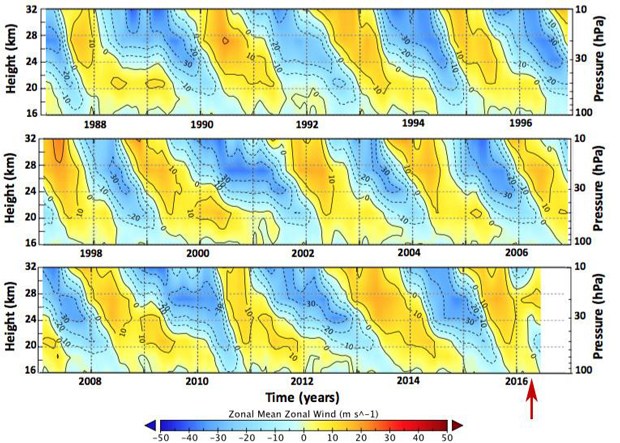Unexpected changes in high-level equatorial winds surprise scientists
 Profile of equatorial winds for 13 QBO cycles. Yellow = east winds, blue = west winds.
Profile of equatorial winds for 13 QBO cycles. Yellow = east winds, blue = west winds.One of the most repeatable, predictable phenomena of atmospheric winds threw scientists for a loop February 2016 by breaking its long-standing routine. However, a study published last week in Science presents a mechanism to explain this unexpected and unprecedented disruption. The international group of atmospheric scientists was led by Scott Osprey of the National Centre for Atmospheric Science at the University of Oxford, and included Kevin Hamilton, recently retired professor of atmospheric sciences, and Chunxi Zhang, atmospheric modeling specialist, both with the International Pacific Research Center (IPRC) at the University of Hawaiʻi at Mānoa.
The primary cause of the QBO disruption determined by the study was atmospheric waves transporting momentum from the Northern Hemisphere southward to the equatorial region, thus causing the formation of a westward wind-jet, which disrupted the eastward flow. Analysis of very long term computer climate simulations illustrated that one model spontaneously produced similar disruptions of the QBO, but with a frequency of less than once per century.
“The development of the upper level winds in early 2016 caught all the experts by surprise,” explained Hamilton, “We cannot be completely sure of how the disruption in the QBO will be resolved. It seems mostly likely that there will be a return to typical QBO behavior through the rest of 2016 into 2017, although reversed in polarity: winter of 2016/2017 was expected to be westward dominated and may instead be eastward dominated again.”
For Europe, that means their winter is likely to have more storms and heavy rain.
Read more at UH News.



